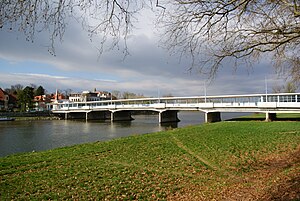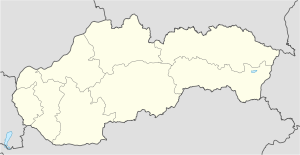Kolonádový most
Coordinates: 48 ° 35 ′ 17 ″ N , 17 ° 50 ′ 24 ″ E
| Kolonádový most | ||
|---|---|---|
| use | footbridge | |
| Crossing of | Scales | |
| place | Piešťany | |
| overall length | 156 m | |
| width | 12 m | |
| Longest span | 28 m | |
| start of building | 1930 | |
| opening | 1933 | |
| location | ||
|
|
||
The Kolonádový most (German colonnade bridge ) is a reinforced concrete bridge opened in 1933 for pedestrians in the Slovak town of Piešťany . It crosses the Váh between the pedestrian zone and the island of Kúpeľný ostrov , where the spas are located. The functionalist- style structure is the longest covered bridge in Slovakia and has been a cultural monument since 1984 .
History and description
The bridge was an idea of the then operator of the spa, Ľudovít Winter , who wanted a covered bridge with a colonnade and shops to protect passers-by in bad weather. The colonnade was supposed to continue on the bank of the Waag, but this project was not implemented. A first project expected a narrow carriageway and two tunnels on either side, but Winter rejected this project because, in his opinion , there would be drafts in the tunnels. Therefore, after a recommendation from Ing.Liewald, Winter selected the then 30-year-old architect Emil Belluš , who had adapted the superstructure according to Winter's ideas. The Austrian construction company Pittel and Brausewetter built the seven-horse bridge between 1930 and 1933 (according to some sources as early as 1932). The construction costs amounted to 3.1 million Czechoslovak crowns . At that time the bridge was also used for automobile traffic.
The Slovak artist Martin Benka decorated the dividing glass with the motifs "Detvianska pieseň" (Song of Detva ) and "Na salaši" (On the mountain pasture). The originals have been in the Piešťany Balneological Museum since 1993, and since then there have only been copies on the bridge. The sculpture of a crutch breaker, created by the sculptor Robert Kühmayer from Bratislava, stands on the city- side portal . Both portals have Latin inscriptions, which are supposed to symbolize getting well in the spa. On the city side there is Saluberrimae pistinienses thermae (The extremely healing baths of Piešťany), based on a poem by the Bohemian writer Adam Trajan from 1642, on the island side Surge et ambula (Stand up and go), according to Mt 9.6 . The concrete pillars are designed as ice breakers to protect against drift ice .
On April 2, 1945, in the final phase of World War II , Wehrmacht units in retreat blew up part of the bridge and severely damaged it. According to a design by Dopravoprojekt, the Doprastav company rebuilt the bridge in 1955 and 1956, so that it could be opened to traffic on December 30, 1956. The renovation cost 3.5 million Czechoslovak crowns.
The now dilapidated bridge will be renovated in a 1.8 million euro conversion by the end of 2020. After the work is completed, the city plans to use the interiors instead of shops for a gallery and presentation purposes.
Individual evidence
- ↑ Pamiatkový objekt - podrobnosti , Monument Office of the Slovak Republic, accessed on May 8, 2020.
- ↑ a b Kolonádový most , register-architektury.sk, accessed on May 8, 2020.
- ↑ Informácie o rekonštrukcii Kolonádového mosta , piestany.sk, accessed on May 8, 2020.
- ↑ a b Peter Paulík: Mosty na území Slovenska . JAGA, Bratislava 2012, ISBN 978-80-8076-103-5 , p. 164-165 (Slovak).
- ↑ Rok 1956: V Piešťanoch obnovili zničený Kolonádový most , vtedy.sk, accessed on May 8, 2020.
- ↑ Rekonštrukcia Kolonádového mosta: Obmedzenia potrvajú ešte niekoľko mesiacov , dnes24.sk of February 15, 2020, accessed on May 8, 2020.



